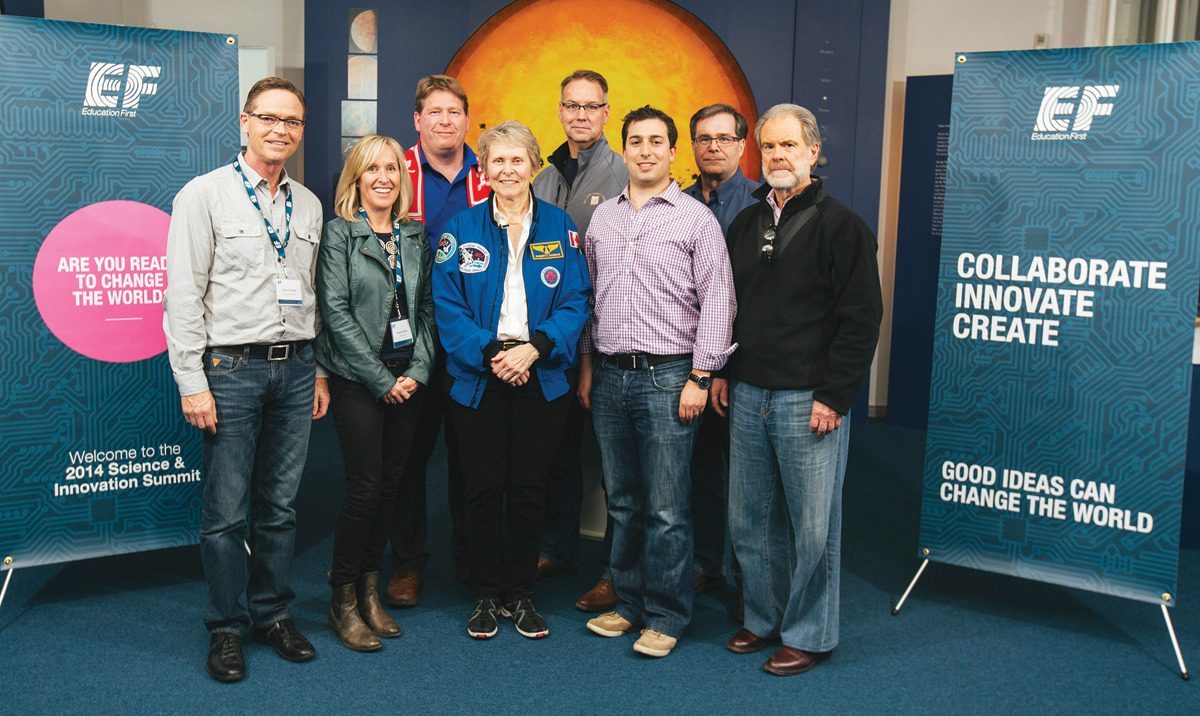This past March, I had the pleasure of accompanying EF Educational Tours and a group of Canadian school board administrators to the EF Science & Innovation Summit in Berlin. The purpose of the summit was to combine educational travel with experiential learning to help students develop 21st century skills. As my colleagues and I witnessed, the students who attended the summit gained firsthand understanding of what it means to be innovative through exploration, inquiry and discussion.

Chris Smeaton, Canadian colleagues and EF representatives meet with Dr. Roberta Bondar at EF’s Science and Innovation Summit in Berlin.
The summit opened with an inspiring keynote address and question and answer period with world-renowned Canadian astronaut, Dr. Roberta Bondar. Students were challenged to dream big, follow their passions and be self-reflective. It was a powerful start to the process where students were going to be actively engaged in the four Cs: creating, communicating, collaborating and critically thinking. This is certainly the direction that contemporary education is going and aligns perfectly with preparing students who will be “Engaged Thinkers, Ethical Citizens with an Entrepreneurial Spirit!”
Together, EF Educational Tours Canada and Evergreen, Canada’s leading environmental organization connecting schools and communities with nature, designed four exciting workshop challenges for the students participating in the summit. Each challenge focused on one of four themes: energy, food, transportation or architecture. Throughout the process, expert facilitators engaged students and provided a context for the challenge scenario for each topic.
- The energy challenge asked students to develop a solution to reduce their school’s energy use by fifty percent.
- The food challenge prompted students to re-design their cafeteria experience to include sustainable food choices and practices while increasing usage of the space.
- The transportation category tasked students to redesign their commute to school and reduce their overall environmental impact.
- The architecture challenge required students to recreate their school space and grounds to reflect sustainable design.
Design thinking, a problem solving process, was a fundamental part of the summit. The process began with identifying a problem and examining it through various lenses, where opportunities and challenges were brainstormed within a group setting. Although slow to start—the students needed time to get to know one another—the end result was the perfect blend of creativity and collaboration!
The students were then led through the five-step design thinking process that culminated with presentations of their final products in the evening. This process, designed by Guido Kovalskys, directed students through the following:
- Empathize – Students were required to list the potential audiences who might be influenced by their challenge. What might be their concerns? What might be the impact of their project? Eventually, the students decided on one target audience that would be most impacted by their solution.
- Define – Students began by listing the values attributed to their solution. The goal of this step was to define their statement of purpose which included their lens, audience and theme.
- Ideate – The ideate stage began with a reflection and sharing their statement of purpose with other groups. This allowed for refinement if necessary. Students began to “blue sky” and developed solutions that were bold. The mentality around ideate is “Yes, and…” not “Yes, but…” which was extremely liberating for participants.
- Prototype – Students began to sketch their ideas and draft their design plans. Several inspirational quotes were presented to the students during this phase, and two in particular caught my attention. The first, from Hasso Platner of the Institute of Design at Stanford was, “Build to think and test to learn.” The second came from one of the slides and simply stated, “If a picture is worth a thousand words, a prototype is worth a thousand pictures.” Prototyping is the “doing” phase, the hands-on action. The final portion of the event was completing their prototypes and then presenting them to other participants and the judges. The ability to showcase their prototypes demonstrated how the four Cs of contemporary education had been realized.
- Test – This phase was beyond the scope of the Summit but has significant implications for the process in the classroom. It is the opportunity to test out the prototypes and extend the learning.
Multiple learning outcomes were achieved through active engagement. It was messy, but it demonstrated exactly the direction required for education. Educators should not be afraid to let students roll up their sleeves and have a hands-on experience. Students must move from consumers of information to creators of information. They must be able to work with others in a collaborative environment and communicate clearly and concisely. And finally, the problems of tomorrow will not be solved with often-used linear thinking. Critical thinking, bold and divergent, must be given its proper place in today’s classrooms and the Science & Innovation Summit provided an excellent example of how this can be achieved.
I would encourage students and educators from across Canada to participate in next year’s summit, which will encourage students to explore the idea that not everything has been invented yet. EF’s Leadership & Innovation Summit is taking place in Barcelona in March 2015 and will feature keynote speaker and English physicist Dr. Brian Cox. To find out more, visit eftours.ca/science.
ABOUT THE AUTHOR
Chris Smeaton
Chris Smeaton is Superintendent, Holy Spirit Roman Catholic Separate Regional Division No. 4, Alberta.
This article is from Canadian Teacher Magazine’s Sept/Oct 2014 issue.












